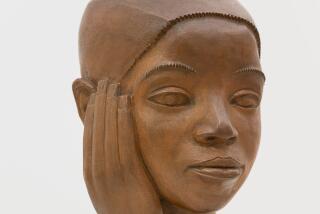Oklahoma Artist Finds Fame in the Traditional
OKLAHOMA CITY — Doc Tate Nevaquaya doesn’t know what course his life might have taken if his cousins hadn’t happened along while he was trying to hitchhike.
“I was going to Oklahoma City to join the Marine Corps,” recalls Nevaquaya. “They bought me a ticket and put me on the bus for Lawrence, Kan., to enroll in a trade school. I had 35 cents in my pocket.”
Times have changed for Nevaquaya since then. He now is an internationally acclaimed artist whose work includes designing a shield on the Tomb of the Unknown Soldier at Arlington National Cemetery. He also sold a painting to England’s Queen Elizabeth II for about $1,200.
Nevaquaya paints in the traditional two-dimensional Indian style, which often has the main object or feature outlined. Some work is a flat dimension, resulting in a semi-abstract work. His canvas, “Native American Church,” depicts 16 figures involved in religious ceremonies.
Nevaquaya’s paintings range in price from $500 to $7,000.
Most of his work is done in watercolor. “I feel that most closely depicts the effects of the earth pigments,” Nevaquaya says.
The hitchhiking incident isn’t the only time that a seemingly minor event played a part in changing the artist’s life.
“I first heard the Indian flute about 1939, when I was 7,” Nevaquaya says. “I thought it was so beautiful, but even then it was dying out. I decided that someday I would learn to play the flute.”
It was a concern of trying to preserve a part of his Indian heritage that was rapidly disappearing, he says.
But other pursuits became paramount until 1947, when Nevaquaya bought a suitcase at a pawnshop. “There was an old metal whistle in the suitcase, similar to the flute. I experimented with it and decided then I would learn how to make flutes and play the flute.”
In 1986, Nevaquaya received a $5,000 National Heritage Fellowship from the National Endowment for the Arts for preserving and developing a renewed interest in the Indian flute. The citation hailed him for being “one of the few remaining artists” to link past generations with the future.
Nevaquaya also has been the subject of television documentaries, has appeared with country music star Roy Clark, has played at the Kennedy Center for Performing Arts in Washington, and appeared on British television while on a goodwill tour sponsored by the State Department and the Smithsonian Institution. He has appeared in concerts or lectures in Europe and the Far East.
Nevaquaya has taken the Grand Award for his paintings at various art shows, including exhibitions in Chicago and Albuquerque, N.M.
However, there was a time when the future didn’t look all that bright.
Nevaquaya, formally Joyce Lee Tate Nevaquaya, was orphaned when he was 13. He lived for a time with an older brother in the Apache-Fletcher area of rural southern Oklahoma. Both the nickname “Doc” and the “Joyce” are in honor of Dr. C.W. Joyce, a physician for whom many Indian children in the Fletcher area were named.
It was while he was living with his brother that he started the fateful trip to Oklahoma City to enlist in the Marines.
“I had just started hitchhiking when my cousins picked me up,” Nevaquaya says. “If they hadn’t come by, within a few minutes my whole life might have been changed.”
Nevaquaya says his brother didn’t know where he was or where he had gone until he wrote him a letter from the trade school, which now is Haskell Indian Junior College.
Although Nevaquaya says he painted and sketched in the 1940s, he stayed away from the art classes while attending the Ft. Sill Indian School because he did not like the policy that discouraged all painting except portrayals of traditional Indian culture.
His interest in art was honed by the fact that an early neighbor had been Allan Houser, a painter who now is an acclaimed sculptor. He later met and became friends with artist Black Moon Riddles.
Although he sold a few of his paintings in the early 1950s, he painted and sketched in his spare time while holding down a job. Then, in 1955, Doris Littrell of Oklahoma City sought him out after seeing some of his work at the Southern Plains Indian Museum in Anadarko.
From that point on, Nevaquaya made art his vocation.
Nevaquaya is in demand for his expertise with the Indian flute as are his paintings. He frequently holds workshops and has taught his sons--he has five, along with four daughters--to play the flute.
More to Read
The biggest entertainment stories
Get our big stories about Hollywood, film, television, music, arts, culture and more right in your inbox as soon as they publish.
You may occasionally receive promotional content from the Los Angeles Times.










